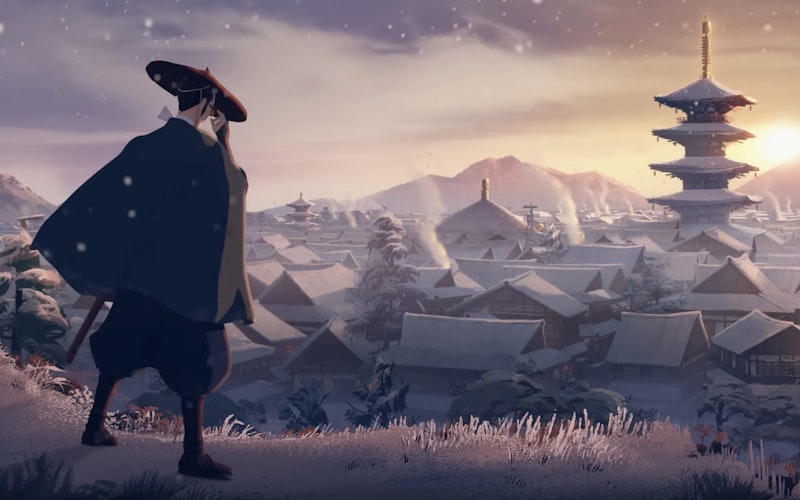
TV
Balancing Bloodshed and Beauty in Blue Eye Samurai
It may not be very honoring of the sixth commandment to say so, but bloodshed has never looked more beautiful than it does in Netflix’s adult animated series Blue Eye Samurai.
The show takes place in 17th-century Japan, where non-Japanese individuals are banned from the country. It follows Mizu (voiced by Maya Erskine), a warrior who—by being a mixed-race woman—is doubly outcast. Angered at her ostracization, she aims to hunt down the white man who raped her mother and is rumored to be illegally hiding in Japan. As Mizu bloodily carves her way through assassins and samurais to get to her prey, the duels are at once hard to stomach and strikingly engrossing. They ultimately underscore the series’ central motifs: that there is beauty to be found in what the world might deem “impure” and that there is a holy role for anger in living out one’s faith.
In the vein of its mixed-race protagonist, Blue Eye Samurai uniquely combines 2D and 3D animation styles, which makes each scene feel like the characters are inhabiting a painting. Usually with animated projects, creatives storyboard what happens way in advance and then build the sets to match what has been choreographed. However, with Blue Eye Samurai, producer and director Jane Wu wanted to shoot the show “from a live-action perspective.” This required the 2D environments to be built first and given their own life; the choreographers could then stage the 3D action in ways that responded in live time to the sets. This results in landscapes that live and breathe just like human characters. In one of the series’ standout sequences, Mizu is in a standoff with an assassin on a rocky shore. Each time their swords clash, the waves—in vibrant hues of orange and pink—violently crash against the jagged rocks, creating a call-and-response dynamic between water and blade that feels distinctly liturgical. Each splash also acts as a precursor to the blood that will inevitably be drawn between these two, with the violent sea acting as an amplification of the storm that rages within them.
The elegance of Blue Eye Samurai’s multilayered aesthetic reinforces one of the show’s central themes, namely that beauty and fullness lie not in exclusionary purity but in inclusive “impurity.” In a scene that could be a thesis statement for the show, a young Mizu (voiced by Orli Mariko Green) is learning how to build a sword from her master, Eiji (voiced by Cary-Hiroyuki Tagawa). Eiji instructs her that, contrary to popular belief, you don’t want to beat all the impurities out of a metal when making a sword. If a blade is too pure, it becomes brittle and shatters easily. It is only by letting the metal retain some of the impurities that the sword holds its structural integrity.
The duels are at once hard to stomach and strikingly engrossing.
This statement applies as much to swords as it does to the well-being of one’s soul. For most of the series’ runtime, Mizu’s singular rage at the outside world and subsequent hatred of herself are all that guide her. It is hard not to empathize with her resentment over the xenophobic, misogynistic, and patriarchal attitudes that have forced her to not see her gender and mixed-race heritage as gifts to explore but as curses to scorn. Yet ironically, in operating solely from self-hatred and rage, she has become the very evil that the most bigoted of her country folk accuse her of being. Eiji comments wryly to Mizu after a battle gone wrong, “There may be a demon in you, but there is more. If you do not invite the whole, the demon takes two chairs.” Indeed, Mizu learns that while her frustrations are justified, there is a way to relate to them and weave them into the spectrum of her interior life in such a way that it does not have to hollow her out. The soil of her soul needs more than anger to sustain it. Although she remains committed to her blood-soaked journey, she eventually allows herself to feel gratitude towards the likes of Eiji and her self-appointed apprentice, Ringo (Masi Oka), who have stuck by her side.
Watching Mizu learn to balance her righteous rage made me grateful that while the Bible warns us to be “slow to anger” and to “not let the sun go down while you are still angry,” there are also reminders that anger can be a tool for justice. I’m encouraged that even Jesus flipped tables to drive out those who turned his own home into a site of exploitation. To live in a world that is still rife with the same xenophobia, misogyny, and patriarchy found in Blue Eye Samurai is to be in a state of rage; the Gospel makes room for us to be a people who can be always rejoicing while also steadily groaning.
While Blue Eye Samurai ultimately leans a bit too heavily on violence to be a perfect Christian parable, the series still reminds us that rather than be ashamed of our anger, we can embrace and harness it to live a full life. May the themes and art of Blue Eye Samurai, which mix seemingly disparate elements to create something whole and beautiful, remind us too that our emotional landscape is enriched when we don’t beat out the seemingly “impure” emotions such as anger, but rather find a way to meld them into our faith.
Topics: TV